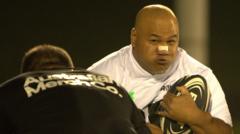The Run It Championship League, which has quickly emerged as a viral spectacle, faces scrutiny over its safety protocols and the messages it sends to young players.
**Run It Championship League: The Controversial Rise of a Collision Sport**

**Run It Championship League: The Controversial Rise of a Collision Sport**
A backyard game finds itself on the global stage amid safety concerns and cultural implications.
In the heart of competition and camaraderie lies the emerging sport known as the Run It Championship League (RUC League), a game that has captured the attention of audiences worldwide with its electrifying confrontations. Originating from the Pacific Islander communities in Australia and New Zealand, this collision sport invites competitors to engage in a one-on-one tackle match without protective gear. The intense physicality is designed to dominate the opponent, which has become not only a viral sensation but also a cause for concern among medical professionals.
The sport has garnered millions of views online, thrilling fans with videos displaying the raw energy of competitors slamming into each other. With significant sponsorship deals and plans for expansion into markets like the UK and the US, the RUC League is not merely a grassroots pastime; it aims to carve out a niche on the international sporting stage. The next major event is set for Dubai, where competitors will vie for a lucrative prize, raising the stakes even higher.
However, the ascent of the RUC League has not come without criticism. Advocates for safety are increasingly vocal, citing the potential dangers of unregulated physical contact. Medical practitioners, including neuroscientists and sports figures, have raised alarms over the risks associated with such an aggressive format. They emphasize the sport's link to incidents of head injuries and long-term neurological impacts, underscoring the dangers presented to amateurs attempting to replicate the game in less controlled environments.
In response to these concerns, the league assures that safety protocols are in place, including thorough medical screenings and immediate access to health professionals during events. Yet skeptics argue that no amount of preparation can eliminate the inherent risks associated with high-speed collisions.
Adding to the complexities surrounding the league is the cultural narrative it perpetuates, particularly regarding masculinity and the perception of strength. Critics, including mental health professionals, suggest that the sport may propagate harmful stereotypes that equate resilience with a willingness to endure pain. They warn that this mindset can have adverse effects on young players, encouraging dangerous behaviors in pursuit of validation.
While the league founders insist they are promoting a competitive sport driven by skill, the realities of physical harm and societal implications loom large. With official bodies like Rugby Australia distancing themselves from practices akin to the RUC League, the future of this new collision sport hangs in a precarious balance as it navigates the path between entertainment and safety. What began in Australian backyards may soon redefine borders of competitive sports, but at what cost?




















